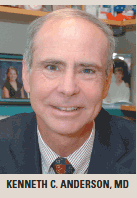Complete response rate is improved with this regimen
This is one of a number of studies that show that adding novel drugs to conventional treatments can achieve higher response rates in multiple myeloma,” said Dr. Anderson, who is the Kraft Family Professor of Medicine at the Dana-Farber Cancer Institute in Boston.
This is one of a number of studies that show that adding novel drugs to conventional treatments can achieve higher response rates in multiple myeloma,” said Dr. Anderson, who is the Kraft Family Professor of Medicine at the Dana-Farber Cancer Institute in Boston.

“The VISTA trial showed the advantages of adding bortezomib to melphalan and prednisone for both progression free survival and overall survival (NEJM 359:906-917, 2008). This (Italian) trial aimed to improve on that regimen by adding thalidomide. With very early follow-up data, we can see that the complete response rate is improved with this regimen,” he said. “And while it’s too early to tell whether the progression-free survival and overall survival are better in the VMPT arm, it’s likely that these rates will improve over time.”
“The second important point about this trial, he said, is that in an elderly population, changing bortezomib from a twice-weekly to a weekly schedule improves its tolerability. “This was a very interesting study because it added two novel therapies to the conventional chemotherapies. And it’s certainly a regimen we might see in the future,” Dr. Anderson said.
How Supportive Care Methods Can Improve Oncology Outcomes
Experts discussed supportive care and why it should be integrated into standard oncology care.